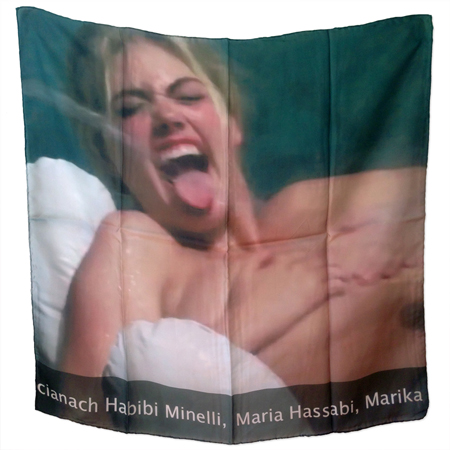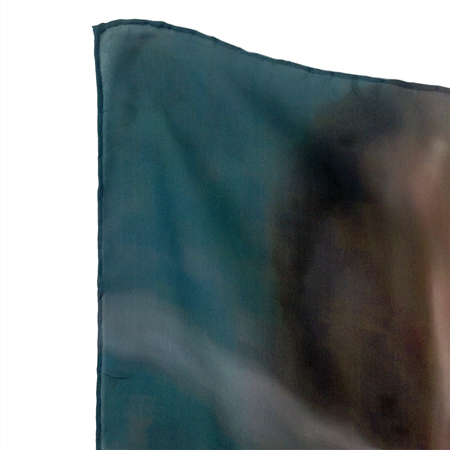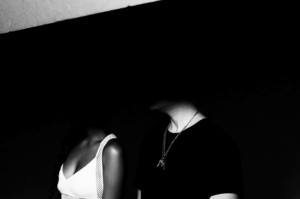“It’s like getting mad at the weather or something”, says Justin Swinburne, a visual artist and one half of cloud-based musical project 18+, about the (non-) ethics of appropriation, “this is just how the cultural media landscape exists now”. Swinburne’s voice is beaming from New York, bouncing off a satellite and running through my laptop speakers in London. His collaborator Samia Mirza is joining us from LA. This is a three-way conversation that is literally crossing time and space and I’m left with no doubt that said “cultural media landscape” is a very strange one indeed. The work of 18+ is even stranger.
The project is one that has been lingering just beneath the surface of online data noise since roughly 2011. It was a faceless audiovisual project with a frustratingly search-engine evading name that amorally seized and assimilated existing beats, images and video to produce some of the most intriguing work to come out of the obscured ‘internet band’ ether in the past few years. M1XTAPE, MIXTA2E and MIXTAP3 were released in that time, before the slick and sensual style built on a fetishistic approach to sculpting stolen content became something that could be sold. Hence the debut album, Trust, to be released on London label Houndstooth on November 10, and a growing list of live performances that are stepping out of the art scene and into the industry.
What sparked my own interest in the band – beyond a purely audiophile fascination as a part-time music journalist – was the beats credited to the likes of artists/art projects Kareem Lotfy and AIDS 3-D, as well as the fact 18+ had performed IRL at last year’s defining Venice Biennale, New York’s Artists Space and Trouw Amsterdam, at the same time as showing up on the bill at Berlin’s Creamcake and frequently being featured in straight up music websites. What was even more interesting was that the documentation of these events has since been somehow reintegrated into the 18+ oeuvre, whether in a field recording of a gushing fan in MIXTAP3 interlude ‘cologne’ or applause from a live audience at the Lithuania and Cyprus Pavilion in ‘venice feat raimundas’.
A recent performance at LA’s REDCAT Theater was prefaced by a YouTube video featuring music and CGI animation of images printed on virtual fabric, rotating in suspension to the tune of some kind of freakish nursery rhyme as Mirza and Swinburne moan “playing with your heart so broken up/ I’ll give you a bit of magic touch”. These are images of androids and Second Life avatars, a photo of a baby and model Sam Way, even a film still reappropriated from the already appropriated imagery of the 2013 promotional video for their Venice performance. In fact, all of them are stills of 18+ videos, made from images taken from the web and reintegrated into their work to eventually become these art objects that are essentially merchandise. Presumably they’re the kind that look like the animated accessories on the REDCAT video but ones you can touch (physically rather than ‘magically’). I haven’t actually seen these silk scarves for real but for now the jpegs will do because when it comes to 18+, I don’t think it makes a difference.

I had a friend who interviewed you a while ago and they said your names were John and Jane Doe.
Justin Swinburne: Yeah. That’s a by-product of a thing that was forced upon us by the internet. So when Google+ came about, it started forcing this anti-anonymity thing with YouTube accounts and Google accounts. They forced us to add a real name to our Gmail account, which is shared, so there’s no reason why there would be my name or Samia’s name. So ‘Jane Doe’ is just a generic female name for an anonymous body used by police/morgues. We just said that because it’s a placeholder.
So now you’re starting to mould into a format that’s got a lot of potential, in terms of being a very marketable; what are your thoughts on that, especially as visual artists.
JS: I think, no matter what creative field you’re in nowadays, you have to diversify your output in order to stay afloat economically. So what we’re planning is we want to design products – we want to design clothing, we want make art exhibitions, we want to collaborate with as many people as possible – but always in this way that seems somewhat critical of this need to capitalise or need to merchandise. I think a lot about Merlin Carpenter’s Tate Café show. We’re planning a lot of objects that are going to come out soon and it’s almost like banal design or something like that. It reminds me of the MoMA design store.
Samia Mirza: Yeah.
JS: There are a lot of interesting things going on in the store but it has this tacky quality to it because it’s so blatantly trying to further monetize an already established and globally recognized brand. I think your average creative person is constantly trying to balance these things and I don’t know if it’s positive or negative, but it’s just the way things are.
SM: I think we’ve built a triage within art and music without trying to do so. It places us there because they all demand something cool, sexy, exclusive, and anonymous, and popular [laughs] and it’s getting into fashion as well. That’s kind of how we’ve been operating, but these objects have been a new thing. They’re not merchandise and not quite artworks either. They’re something in between. We’re making these things that happen to exist in these realms.

I’m a bit conflicted about that. Obviously, it’s difficult to survive as an artist, so you become this industrial creative producer and at the same time some of the most interesting art now is exploding these distinctions between disciplines, platforms and formats. But then what are you left with? It’s like this loop of criticality and complicity but it’s also pretty emblematic of the time.
JS: Yeah, that sort of feedback loop and questionable morality is definitely on my mind all the time. Artists are small businesses that are driving an economy. It’s a very real aspect of being an artist, that if you’re getting play and you’re selling works in galleries you’re a legitimate and pretty healthy small business. It’s weird to think about artists that way, as being this driving force in capitalism that fuels our society. It’s discordant with the knowledge that most artists tend to align themselves with a very leftist ideology but then they go ahead and they fall in line with this laissez faire capitalist attitude. Yeah it’s conflicting. It’s confusing but it’s hard to escape and that’s the point.
When you mention the design store at MoMA, I was at a fair recently where I couldn’t tell the difference between the prints being exhibited as art and the editions being sold as design objects.
JS: Right, and it’s maybe uncomfortable but then there’s also the idea that if an object can be reproduced and syndicated and be in tonnes of people’s homes, then what’s wrong with that? Why shouldn’t there be a more accessible version? Then the conversation often becomes the ‘elitist versus populist’ problem.
Maybe that’s why there’s so much popular culture informing art.
JS: Right.
SM: I would also say that a huge part of our process is that 50 per cent of the work that we do is appropriated – from the videos we use to the people we work with. Whether it’s Second Life videos that nerds are making to create their dream island or their dream girl… even in the way that we find objects that we want to make, it’s just taking things of the world and somehow integrating it into our practice and responding to it.
That includes all the beats, including the way we work with others. It’s something I think that people see often in the stuff that we’re doing, even in the way that we find objects. We’ve been making these dinner plates and at the Biennale, we had towels with the name of our favourite Korean restaurant on it; we’re just pulling things from around us and adding them to this ‘brand’, which is a product of our lives and tastes.

I suppose it’s just another medium, or discipline that you have access to. If you have access to all these different modes of expression and you know how to use them, then why not?
SM: We both still have our own practices, but being a novice or being new to some kind of genre or format in working, to me, was really refreshing and encouraging to keep doing this. Because there was also no definition to begin with and it felt really good to work in that because we came to it with no rules. Whereas with our practices, I think we had a style and had things defined.
SM: We also had desk jobs. We would go to the office and what we had were our computers so it was something I could do at work [laughs]. I had fast internet and what could I do? I could upload videos, download videos, send them to Justin and it just seemed like the most malleable format for making and communicating.
When you use other artist’s beats do you ask their permission?
SM: Some of them.
JS: It depends, now everything’s becoming legal so if we’re putting out stuff with beats that we’ve just taken, we’ve had to track down the people who had made them originally and get them to sign on to do something. But everyone seems really agreeable and willing to participate.
I guess the more popular you become the more trouble you’re going to start having.
JS: Definitely. But we also have more people helping us.

You might have to be taking down a whole lot of video.
JS: But then the scarcity of that video will increase, and its value might increase. I mean so long as we have the right lawyers it’s going to be fine [laughs].
I personally make a distinction between who you can and can’t steal from. Like if it’s a huge brand as opposed to a small time artist. And when you start making money from this content it’s a whole other issue…
SM: At least in the way it started with ‘Drawl’ and the video of the lady in the ocean, I thought that we were just as small, if not smaller than the person who made that original animation. And this was just us using what they were making as a visual accompaniment to our new activity.
At that point we didn’t even know we were making ‘music’. The initial gesture of appropriation was as light as other mashed content today, like a video of a girl from her bedroom singing over a Michael Jackson song or something. There was no money being made and there still isn’t, in terms of the visual stuff. So I don’t personally see it as stepping on anybody’s toes. I don’t even know what we would fight over, perhaps it’s just an issue of packaging.
JS: And even if it is, we’re maybe a symptom of a larger issue. Like tonnes of ‘original content’ that I’ve personally made has been assimilated into tonnes of contexts that I would never want but that’s just the way it goes. It’s like getting mad at the weather or something. This is just how the cultural media landscape exists now. And if you get mad about copyright of an image you took of a mountain or something, it just seems backward looking. I empathise, but you have to think beyond that at some point.
When you say you can get appropriated into contexts that you might not want to be appropriated into, it’s almost like a literal expression of what happens with creativity and invention: Einstein split the atom, then the military made the atom bomb.
JS: Yeah exactly. You can’t predict the future of your inventions. You basically decide if you want to participate in the world or not. You decide if you want to communicate with it and if you decide to communicate with other people, you’ve given up a certain aspect of yourself and you just have to live with that.
SM: Right, especially with the internet. Once you put something out there you can’t expect it to be yours anymore. Everything comes out of a context and everything is a version of something else.

It’s like how some cultures consider a photo to be a theft of the soul. In a similar way, you’re surrendering a part of yourself when you produce work.
JS: Yeah that’s absolutely true. And I think that’s something we’re probably going to deal with more directly in the future. We’ve been dealing with avatars as an idea in the past, and now as we start presenting our bodies more and more, as this almost public figure, our physical selves are becoming this sort of avatar for 18 + or something. Then there’s this division of ‘self’, of who we are as individuals – as people who do our own laundry and clean up after ourselves – and then this person who is a singer of a band that maybe becomes an almost two-dimensional character to our audience. That’s something we’ve been thinking about actively.
It’s content and it’s interesting and everyone is doing it to themselves now with internet accounts and stuff like that. Everyone is their own publicist and everyone is constantly presenting a flattened version of themselves, where they’re only having a good time and they’re only doing good things and they’re only…
SM: …looking good.
JS: You get to present the best case scenario at all times and its only just a sliver of your reality. **






